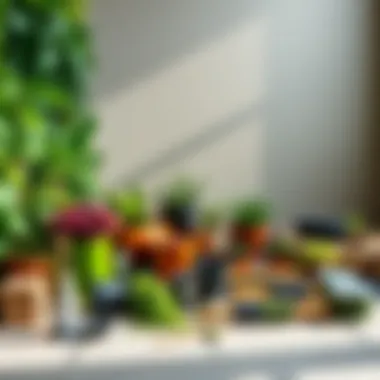Exploring Living Wall Kits: Design and Benefits


Intro
Living walls, often referred to as vertical gardens, are swiftly gaining popularity as a means to integrate nature into everyday spaces. They offer not merely an aesthetic appeal; these green installations contribute significantly to improving air quality in urban environments and can enhance biodiversity. The essence of a living wall kit lies in its simplicity and convenience—allowing even those with limited space or gardening experience to cultivate plants in a vertical format.
In this exploration, we delve into the nuts and bolts of living wall kits, elucidating their design components, practical applications, and the benefits they bring to horticulturists and novices alike. Whether you’re a seasoned professional or just beginning to explore the wonders of gardening, understanding these concepts is vital when considering the implementation of a living wall.
Key Concepts and Terminology
Definition of Terms
To comprehend living wall kits adequately, certain terminology merits explanation.
- Living Wall: This refers to a wall partially or completely covered by vegetation, where plants are grown in soil or other substrates.
- Vertical Garden: A synonymous term with living walls, focusing on the gardening aspect in an upright orientation.
- Modules: These are the individual planting containers that are often included in living wall kits. They can be mounted on walls and contain the necessary materials for plant growth.
- Irrigation Systems: Equipped within many kits, these ensure that plants receive sufficient water, often through drip systems.
Understanding these terms helps in navigating the diverse options available in the market and aids in selecting the most appropriate kit for specific needs.
Overview of Relevant Practices
Creating a thriving living wall involves various horticultural practices:
- Plant Selection: Choosing plants that thrive vertically and in the specific environment of your home or work space is critical. Considerations include light availability, humidity levels, and temperature.
- Watering Techniques: Effective irrigation is necessary not just for aesthetics but also for the health of plants. Knowing how to properly hydrate your living wall can make or break the success of your installation.
- Maintenance Routines: From trimming to pest management, regular upkeep ensures that the living wall remains vibrant and healthy throughout the seasons.
Current Trends and Innovations
Latest Research and Developments
The advancements in living wall technology continue to evolve, thanks to innovative research in botany and horticulture. Recent studies have highlighted how properly designed living walls can significantly reduce urban heat islands through natural cooling. Furthermore, researchers are exploring the use of native plants in living wall kits to maximize ecological benefits and reduce maintenance demands.
Emerging Technologies and Tools
Tools specifically designed for maintaining living walls are coming onto the scene. Automated watering systems, integrated sensors for monitoring soil moisture, and even smartphone applications for plant care are now becoming commonplace. These tools provide hands-free care options tailored for busy horticulturists or those new to gardening.
"Living walls are not just a trend; they signify a shift towards sustainable urban living, promoting both aesthetic beauty and environmental well-being."
Practical Applications
Step-by-Step Guides
Starting with your living wall can seem daunting. Here’s a brief overview to get you moving in the right direction:
- Select the Right Location: Take time to find a space that receives adequate sunlight.
- Choose Your Kit: Based on plant preferences and personal style, select the appropriate living wall kit. Make sure it includes a suitable irrigation system.
- Arrange Your Plants: Before committing, lay out your plants to see how they look together. Consider their height, color, and growth patterns.
- Install Your Kit: Follow the manufacturer’s instructions closely for installation.
Troubleshooting Common Issues
Even with diligent care, issues might arise:
- Overwatering: This is a prevalent problem. Ensure that the drainage is effective and monitor moisture levels.
- Pest Infestations: Regularly check for pests like aphids or spider mites. Using organic pesticides as a preventive measure can be beneficial.
- Light Adjustments: If plants are not thriving, evaluate whether light levels are sufficient or too harsh.
By understanding the varied aspects of living wall kits, from essential terminology to practical application steps, you�’ll be better positioned to create your own flourishing vertical garden. This approach not only decorates but also nurtures the environment, melding sustainability with creativity.
Prolusion to Living Wall Kits
The concept of living walls, also known as vertical gardens, brings a breath of fresh air—quite literally—to both urban and rural settings. They are not just a modern trend; they serve practical purposes and enhance our surroundings in multifarious ways. In this piece, we aim to unpack the layers of what a living wall kit entails. These kits offer a thorough solution for those looking to incorporate greenery into their environments without much fuss.
The benefits of integrating living walls into spaces are profound. For one, they can dramatically influence air quality, absorbing harmful pollutants and releasing oxygen. Moreover, they serve as a natural insulator, helping to regulate temperature both inside buildings and in private gardens, which ultimately reduces energy costs. On the aesthetic front, the visual appeal of a lush vertical garden can transform lifeless blank walls into vibrant showcases of flora. Such enhancements not only improve one's mood but also foster a connection to nature—even in densely populated areas.
Products aimed at DIY enthusiasts simplify the process of installing a living wall, breaking it down into manageable components that are easy to handle. But aside from the kits themselves, one must consider the care and maintenance involved. Understanding these kits helps potential users prepare for both initial setup and ongoing upkeep, ensuring that their green investments yield lush results for years to come.
In essence, this exploration takes you through the various components of living wall kits, their history, and their overarching significance in today’s environmentally conscious society. Let’s dig deeper into understanding how this botanical revolution came to be.
Definition and Overview
A living wall kit typically consists of pre-designed components intended to facilitate the installation and maintenance of a vertical garden. These kits usually include a frame, growth media, a watering system, and selection guidelines for plants suitable for vertical growth. From herbs to flowering perennials, the choice of flora can make or break the aesthetic and functional value of a living wall. Each component is designed to optimize plant health, integrating seamlessly into the overall arrangement.
Furthermore, these kits are not one-size-fits-all. They vary widely in size, type, and complexity, catering to both novice gardeners seeking to dabble in horticulture and experienced green thumbs aiming for intricate designs. The importance of understanding how these kits function cannot be overstated. Knowledge equips users with the ability to create beautiful installations tailored to their specific needs, ultimately enhancing their creativity.
Historical Context
The concept of vertical gardens first gained momentum in the late 20th century. Though the idea has roots going back centuries in some form—think of ancient hanging gardens—the modern adaptation is often credited to the French botanist Patrick Blanc. His innovative designs transcended traditional gardening methods, where plants were relegated to static ground beds. In 2008, he showcased a wall garden at the Musée du quai Branly in Paris, which garnered significant attention and marked a pivotal shift in how urban spaces were perceived.
Fast forward to the present, and living wall technology is embraced by architects and interior designers who utilize these structures to add life to both external and internal environments. The rapid urbanization process, coupled with the need for smart ecological practices, has catalyzed the popularity of living wall kits across cities worldwide.
As society increasingly gravitates toward sustainable living practices, these kits stand at the forefront of merging architecture with nature, embodying an innovative approach that combines aesthetics, functionality, and environmental responsibility. With climate change at our doorstep, understanding the historical context of these kits helps one appreciate their current relevance and future potential.
Components of a Living Wall Kit
Understanding the components of a living wall kit is essential for anyone looking to create their own vertical garden. Each element plays a crucial role in the overall structure, function, and success of the living wall. From its frame to the plants that thrive within it, every detail matters. This section will dissect the individual components, offering insight into how they contribute to the effectiveness and aesthetic of a living wall. It is not just about planting a few ferns on a wall; it's about crafting a harmonious ecosystem that thrives in a constrained space.
Frame and Structure
The frame forms the backbone of a living wall. It holds everything in place and provides the necessary support for plants to flourish. When thinking about frames, two major aspects must be considered: the material options and the design considerations.
Material Options
Material plays a significant part in the durability and functionality of the frame. Common choices include wood, metal, and plastic. Wooden frames tend to offer an organic look, blending seamlessly with nature, but they may require more maintenance to withstand the elements. On the other hand, metal frames provide durability and strength and can support heavier plants, but they might not offer the same aesthetic appeal. A great choice, meanwhile, is plastic, which is lightweight and resistant to water damage, often proving beneficial for indoor gardens.
Each material has its quirks, and would be wise to evaluate your specific project needs before deciding. For instance, while metal can get quite hot in the sun leading to potential issues for sensitive plants, wood may need treatment to avoid rot.
Design Considerations
The design of a living wall frame is just as important as the materials used. Factors like dimensions, weight-bearing capacity, and ventilation must be analyzed thoroughly. A well-designed frame not only supports plants but also allows for optimal air flow and water drainage. Many people prefer vertical designs to maximize space, but considerations about accessibility for maintenance should not be overlooked. A well-executed design also accommodates aesthetic tastes. This could involve creating patterns or layouts that are visually striking.


Plant Selection
Choosing the right plants is pivotal for a living wall's success. The harmony between plant health and arrangement can either create a lush scape or lead to a desolate patch of brown. This section addresses the essential elements of selecting suitable species and implementing seasonal planting strategies.
Choosing Suitable Species
The plants selected should be compatible with each other and the environment they will inhabit. Native plants offer a fantastic route since they are well-adapted to local climates and conditions. The unique feature here is biodiversity—mixing different species not only looks appealing but also creates a balanced ecosystem that can better resist pests and diseases.
However, it's crucial to consider factors like sunlight, water needs, and growth habits. Some plants are just too thirsty for a wall with limited irrigation capabilities, while others might grow way too fast, overshadowing their companions. Always research and align plant choices with the overall goals of your living wall project.
Seasonal Planting Strategies
Implementing seasonal planting strategies can ensure that your living wall is vibrant all year long. This means selecting plants that can thrive through different temperature ranges and weather conditions. Understanding seasonal habits can also provide a more dynamic visual experience. For instance, integrating plants that bloom in various seasons can keep the display attractive.
This practice encourages ongoing engagement with the living wall, as different seasons bring about floral surprises and variations in color and texture. The downside, however, includes the added complexity of changing plant care as seasons switch.
Irrigation Systems
A living wall must have a reliable irrigation system to thrive. Careful thought on watering is a game-changer in ensuring your plants do not dry out or become waterlogged. This section will focus on drip irrigation and self-watering systems, both popular choices.
Drip Irrigation
Drip irrigation is efficient by delivering water directly to the plants’ roots, minimizing waste and evaporation. This system is favored for its precision; it can be tuned to meet the specific needs of different plant species. Installing a drip system might involve some upfront costs, but it saves time and effort in the long run.
The key characteristic of this method is its ability to maintain consistent moisture levels, preventing stress in plants during hot weather. However, it requires regular maintenance to avoid blockages in the tubing.
Self-Watering Systems
Self-watering systems are designed to limit the need for frequent watering, which allows for more autonomy for the gardener. They store water and release it gradually, ensuring the plants get what they need when they need it. This setup is beneficial for those who travel a lot or have busy schedules.
The disadvantage, however, lies in their initial setup costs and the potential risk of over-saturation. A balance needs to be struck, and understanding the specific water needs of the plants involved is crucial for a successful outcome.
Soil and Growth Media
The substrate chosen for planting in living walls affects both plant health and overall wall stability. This section explores soil substrates and nutrient management, both essential parts of successful horticulture.
Types of Soil Substrates
A variety of soil substrates can be utilized for living walls, from all-purpose garden soil to specialized mixes designed specifically for vertical gardening. Aerated substrates like coconut coir or expanded clay pellets aid drainage and prevent water retention, benefiting plants that require well-draining conditions.
Each substrate type has unique benefits; for instance, coconut coir retains moisture while allowing for aeration, making it a great all-rounder for many plant species. But be mindful—some substrates tend to leach nutrients faster than others, necessitating more frequent amendments.
Nutrient Management
Managing nutrients is a fundamental aspect of sustaining a living wall. Plants require macro and micronutrients to thrive. Incorporating organic fertilizers helps to enhance the nutrient content naturally, while also promoting soil health. Nutrient management isn't a one-size-fits-all solution, as each plant may have specific needs.
The balance between giving enough nutrients and avoiding over-fertilization is tricky. Testing the soil regularly can guide gardeners toward successful nutrient application, ensuring plants get what they need without the risk of toxic buildup.
In totality, the components of a living wall kit are integral not only for initial success but also for long-term viability. A deep understanding of structures, plant choices, watering solutions, and growth media contributes to creating a flourishing vertical ecosystem.
Benefits of Living Walls
Living walls, often referred to as vertical gardens, are not just a trend in modern landscaping. They serve multiple purposes that tap into both aesthetic enhancement and environmental improvement. This section will explore various benefits of living walls, illustrating why they’ve gained traction among horticulturists and urban planners alike.
Aesthetic Enhancements
One of the first things people notice about living walls is their breathtaking visuals. A well-designed vertical garden transforms a bland wall into a burst of color and texture, drawing the eye and elevating the overall appeal of a space.
- Visual Variety: Plants come in diverse shapes, sizes, and hues, which opens up a world of creative possibilities for design. It’s like having a canvas that changes with the seasons.
- Attracting Wildlife: Living walls can attract birds and butterflies, making any space feel more connected to nature.
Moreover, the presence of greenery can soften harsh lines of urban architecture, offering a refreshing contrast that invites tranquility into bustling environments. This combination of beauty and biophilia makes living walls a popular choice for residential and commercial spaces alike.
Air Quality Improvement
The quality of the air we breathe is directly influenced by our surroundings, and living walls have a significant role to play in enhancing air purity. They not only look great but also act as lungs for buildings.
Pollutant Reduction
Living walls contribute to air quality by filtering out pollutants. Plants naturally absorb certain harmful compounds and filter dust particles, effectively acting like sponges for various toxic elements in the air.
- Key Characteristic: Their ability to absorb carbon dioxide and release oxygen is crucial. This biological cycle plays a substantial role in reducing the urban heat island effect.
- Unique Feature: Certain species, like spider plants and peace lilies, are particularly effective at absorbing toxins like benzene and formaldehyde. Incorporating them into living walls can create a micro-environment that effectively cleans the air.
As such, implementing a living wall isn’t just a decorative decision; it’s a proactive measure towards a healthier indoor climate.
Oxygen Generation
Connected to the previous point is the concept of oxygen generation. Through photosynthesis, plants take carbon dioxide and turn it into oxygen, a critical process for sustaining life.
- Key Characteristic: This plant-based oxygen generation process not only provides essential air for inhabitants but also enhances overall well-being.
- Advantage: Research indicates that areas with ample greenery often correlate with improved mental health and decreased stress levels, highlighting a more psychological benefit of integrating living walls into residential and commercial structures.
Incorporating living walls in urban settings can lead to cities with better air quality, thus promoting healthier living for their inhabitants.
Thermal Regulation
Living walls aid in thermal regulation, which is important for both the environment and energy efficiency in buildings. They provide insulation for buildings by maintaining cooler temperatures in the summer and warmer conditions in the winter.
- Cooling Effect: During hot months, living walls can lower indoor temperatures naturally, reducing the need for air conditioning.
- Energy Conservation: This leads to lower energy costs, which is a win for both the wallet and the planet.
In summary, the implementation of living walls provides aesthetic, environmental, and economic benefits. By understanding these facets, it becomes clear why living walls represent more than just a gardening trend; they are a step towards sustainable living.
Installation Process
The installation process of a living wall kit is not just a matter of following steps; it’s about laying the groundwork for an ambitious vertical garden that can transform your space into a lush oasis. Understanding this process thoroughly makes it possible to achieve a seamless and successful installation, contributing to the overall health and longevity of your plants. Each aspect—from assessing the site to actually getting those plants in place—plays a crucial role, ensuring that your living wall thrives.


Site Assessment
Light Conditions
When it comes to light conditions, assessing the brightness and quality of natural light in the installation area cannot be overstated. Proper light is the lifeblood of any plant—essential to photosynthesis and healthy growth. If plants don’t get the right amount of light, they don’t grow well and may even suffer from stunted development. Each plant species has its own requirements; for instance, succulents thrive in bright, direct sunlight while ferns might prefer the shade.
A crucial characteristic about light conditions is the intensity. Too much direct sunlight can scorch some plants, while not enough light will lead to leggy growth. Balancing these needs will dictate your plant choice and placement, making it a beneficial consideration when installing a living wall.
- Advantages: Well-assessed light conditions promote robust growth and minimize plant failure.
- Disadvantages: Misjudging these can lead to wasted effort and resources if the wrong plants are chosen for the given light conditions.
Orientation
Following light conditions, orientation plays a pivotal role as well. The direction a wall faces can significantly affect the amount of sunlight it receives throughout the day. South-facing walls tend to absorb the most heat and sunlight, making them ideal for sun-loving plants like tomatoes and herbs. Conversely, north-facing walls get less direct sunlight, more suitable for shade-loving varieties.
The unique feature of orientation is its impact on temperature regulation as well. Sun-soaked walls can offer a cozy microclimate, while cooler orientations could preserve moisture longer. Therefore, understanding orientation allows gardeners to choose appropriate plant species and optimize growth.
- Advantages: Smart orientation decisions can lead to healthier, more vibrant plants.
- Disadvantages: Incorrect orientation choices can result in insufficient light and stunted plant health.
Mounting Techniques
Wall-Mounted vs. Freestanding
When considering mounting techniques, one of the major decisions is choosing between a wall-mounted system or a freestanding structure. Wall-mounted living walls save space and can create a stunning visual effect against your home’s backdrop. They are particularly appealing when looking to define a pathway or create a focal point.
On the other hand, freestanding installations provide flexibility in placement, as they can be moved when necessary and can be more accessible for maintenance. The key characteristic is their adaptability; while wall-mounted structures integrate directly with the architecture of a building, freestanding ones allow for creative solutions in congested areas.
- Advantages: Wall-mounted options require less ground space, while freestanding systems can be relocated as needed.
- Disadvantages: Wall-mounted setups may be limited by structural considerations, while freestanding walls require more open space.
Safety Considerations
Safety considerations during installation are another crucial aspect that can’t be overlooked. Both wall-mounted and freestanding systems must be secure to prevent accidents. Loose installations can lead not only to injury but also to damage to the plants.
When installing a wall-mounted system, it’s essential to ensure that the mounting hardware is strong enough to support the weight of the plants and the water they hold. For freestanding systems, consider the stability against wind or disturbances if placed outdoors.
- Advantages: Proper safety measures protect both people and your investment in the garden.
- Disadvantages: Overlooking safety can lead to costly mistakes and harm to the surrounding area.
Initial Planting
Finally, addressing the initial planting phase requires attention to detail and care. At this stage, follow a systematic approach to positioning each plant according to its height, size, and light needs. Ensuring healthy root systems and proper spacing among plants helps avoid competition for nutrients and water. Additionally, operators might decide on a staggered planting technique to create depth and visual interest.
Maintenance of Living Walls
Keeping a living wall vibrant and healthy is no small feat. Maintenance plays a vital role in ensuring that these vertical gardens not only thrive but also provide the aesthetic and environmental benefits they are known for. Regular upkeep helps to prevent pest infestations, diseases, and deterioration of plant health. Neglecting maintenance can lead to even greater challenges down the line, making early intervention crucial.
Watering Systems Management
The watering system is perhaps the backbone of a living wall's maintenance regime. Managing this aspect correctly ensures that plants receive the right amount of moisture without becoming waterlogged.
- Automated Hydroponic Solutions: These are quite popular among seasoned horticulturists. Many modern systems can be programmed to deliver precise amounts of water at set intervals, which minimizes the risk of over or under-watering.
- Inspector Guides: Some users adopt a more hands-on approach, regularly checking the moisture levels of the soil. A simple moisture meter can go a long way in guiding watering decisions.
Balancing the needs of the plants with the capabilities of the system can significantly enhance the health of the plants.
Pruning and Trimming
Pruning is akin to giving your plants a haircut. It may sound trivial, but this practice is essential for preventing overgrowth and disease. Regular trimming not only shapes the plants but also encourages healthier growth by promoting air circulation.
- Optimal Timing: Generally, late spring or early summer is the best time to prune. This timing allows the plants to recover quickly and flourish.
- Tools of the Trade: Sharp, clean shears are fundamental to ensuring clean cuts. Avoiding jagged edges prevents the risk of disease entering through wounds.
Pruning can be considered an art form as much as a maintenance chore, reflecting the grower's creativity and commitment to plant health.
Nutritional Needs
Understanding the nutritional needs of the plants in your living wall is imperative for their long-term success. Two principal factors come into play: fertilization practices and soil health monitoring.
Fertilization Practices
Applying the right nutrients at the right time can dramatically influence plant growth and health.
- Balanced Fertilizers: Many experts recommend using a balanced fertilizer that has equal parts nitrogen, phosphorus, and potassium, often referred to as NPK. This balanced approach caters to a variety of plant types that may occupy your living wall.
- Organic Options: Organic brands are gaining popularity as they offer a slower, steadier release of nutrients, which can be beneficial over time.
Adopting the right fertilization practices contributes to robust plant health, leading to a flourishing and vibrant living wall.
Soil Health Monitoring
Monitoring soil health is another cornerstone of successful living wall maintenance. It ensures the substrate remains conducive to plant growth.
- Regular Testing: Conducting periodic soil tests can reveal essential information about pH and nutrient levels, allowing for necessary adjustments.
- Healthy Microbes: A living wall benefits from a healthy microbial population within the soil, as they aid in nutrient breakdown and absorption.
Incorporating consistent soil health monitoring helps maintain an optimal environment, ensuring that your plants receive the nutrients they need when they need them.
Challenges in Implementing Living Walls
Implementing living walls comes with its fair share of challenges. While they offer brilliant aesthetic and environmental benefits, it’s crucial to navigate through various hurdles to ensure their successful adoption. This section encompasses key challenges which anyone considering a living wall kit should thoroughly understand.
Structural Limitations
Living walls require robust support systems, as they bear the weight of soil, plants, and water. It's essential that the wall can handle these loads, or else it could lead to structural failures. A common oversight is not accounting for the moisture retention that living walls can introduce, which may weaken the wall over time.
When contemplating installation, consider materials and existing wall condition. Homes with crumbling bricks or aging wood frames could find their structure compromised. Moreover, adherence to local building codes is paramount.
- Key Considerations:
- Weight Support: Assess the wall’s ability to hold the additional load.
- Material Integrity: Verify if the existing materials can cope with moisture.
- Local Codes: Always consult local regulations to avoid potential issues.
Plant Disease and Pest Management


Another challenge associated with living walls lies in plant health. Disease and pests can wreak havoc on a vertical garden, leading to dead plants and wasted efforts. Organic practices, while encouraged, might require extra vigilance, since pests can spread rapidly in a confined space. Finding balances between beneficial plants and potential nuisances is key.
Incorporating strategies to combat these issues thus becomes essential. Choosing pest-resistant plant varieties and maintaining regular inspections can mitigate risks. Additionally, the introduction of beneficial insects might help maintain ecological balance.
Effective disease management not only preserves plant health but also enhances the aesthetic value of the living wall.
- Management Strategies:
- Diversity: Plant a diverse array to minimize susceptibility.
- Regular Inspection: Frequently check for signs of distress.
- Integrated Pest Management (IPM): Use natural predators to control pest populations.
Climate Considerations
Climate plays a significant role in the viability of living walls. Regions with extreme temperatures or unpredictable weather can present additional complications. For instance, in colder climates, plants may suffer from frost damage, while excessive heat could lead to rapid drying out of soil. Tailoring plant selections to adapt to the local climate conditions is crucial; what thrives in tropical areas may not survive in temperate zones. Utilizing irrigation techniques that account for local rainfall patterns also plays an important part in plant sustainability.
- Essential Actions:
- Research: Know the local climate to choose appropriate species.
- Irrigation Adaptations: Modify irrigation systems based on seasonal weather patterns.
- Microclimates: Utilize the aspect of the living wall; sun exposure can differ significantly even on the same wall.
Case Studies and Applications
The journey through the world of living walls is not complete without examining their myriad applications across different settings. Case studies breathe life into the theoretical benefits discussed earlier, showcasing the tangible advantages of integrating living wall kits into residential, commercial, and public environments. These real-world examples illustrate how living walls can transform spaces, improve ecological outcomes, and enhance community interaction.
Residential Implementations
In personal spaces, living walls serve as more than just a decorative element; they transform the ambiance while capitalizing on limited urban space. One notable implementation is in the apartment complexes in New York City, where residents have embraced vertical gardening to combat the concrete jungle. These installations not only add aesthetic appeal but also provide insulation, leading to reduced energy costs for heating and cooling.
Another compelling case comes from a suburban family who installed a living wall in their backyard as a vertical garden. This wall allowed them to cultivate herbs and vegetables while minimizing their footprint. The family reported significant benefits, not just in food security but also in their overall well-being, stating that caring for the plants improved their mental health. 🌱
Challenges still abound in residential settings. For instance, homeowners must ensure proper irrigation systems are in place to prevent water damage on surrounding structures. Furthermore, selecting the correct plant species requires careful consideration of the local climate and available sunlight.
Commercial Uses
In commercial settings, living walls have garnered attention as innovative branding tools and as part of corporate sustainability efforts. A prime example comes from a tech company in San Francisco, where a striking living wall in the lobby attracts visitors and employees alike. This vibrant display not only beautifies the space but also promotes the company’s commitment to environmental responsibility.
Additionally, some restaurants have adopted living walls to supply fresh ingredients directly from their walls, enhancing their farm-to-table approach. Patrons can enjoy meals made with herbs grown on-site, providing a unique dining experience that resonates with eco-conscious consumers.
However, commercial implementations necessitate consistent maintenance schedules to ensure the health of the plants and the integrity of the wall structure. Firms must consider how to balance aesthetic goals with practical maintenance issues, ideally opting for low-maintenance plant varieties that thrive in the given environment.
Public Spaces and Urban Areas
Living walls have found their place in public spaces, creating lush oases in urban environments. A striking case study stems from the installation of a living wall in a small park in Chicago, featuring native plants that not only beautify the area but also contribute positively to local biodiversity. These installations have become focal points, attracting both residents and tourists, and increasing foot traffic to local businesses.
Moreover, cities around the globe have begun to weave living walls into their overall green infrastructure plans, with governments recognizing their role in improving air quality and reducing urban heat. Notable projects like the vertical gardens in Singapore present stimulating data on how greenery can reduce urban temperatures by significant margins.
The success of public installations hinges on long-term commitment from city planners and communities to undertake maintenance and educational outreach, ensuring that citizens understand the benefits of these green havens.
Thus, the case studies and applications of living wall kits provide practical contexts in which the previously discussed benefits manifest. They illustrate the vast potential of integrating nature into urban life, ultimately enhancing the connection between people, plants, and their environment.
Future Trends in Living Wall Technology
As the world leans further into sustainability, living wall technology stands at the forefront, pushing the boundaries of what urban space can achieve. This section highlights the latest trends shaping the future of living walls, emphasizing the innovative approaches and technologies that will help horticulturists and enthusiasts alike maximize their living wall kits. Understanding these trends is crucial, as they not only enhance functionality but also contribute to the eco-friendliness of installations, thereby laying the groundwork for greener cities.
Innovative Materials
In recent years, materials utilized for living wall kits have evolved, moving beyond traditional substrates to include more sustainable and versatile options. For instance, recycled plastics and bio-based composites are gaining traction. These materials not only provide durability but also reduce overall environmental impact. Harnessing lightweight, modular components can significantly streamline installation processes, making them accessible even for the less experienced DIYers. Beyond this, permeability and drainage capabilities featured in these new materials are critical. They help balance moisture levels, which is essential for plant health. In selecting innovative materials, one should always consider how these decisions affect not just aesthetics but also plant growth and sustainability.
- Benefits of Innovative Materials:
- Durability ensures longevity of installations.
- Eco-friendliness aligns with sustainable efforts.
- Lightweight components ease installation and maintenance tasks.
Technological Advancements
Advancements in technology have brought profound changes to living wall systems, enhancing their efficiency and applicability. As urban areas face intense pressure from growing populations and limited resources, these integrated technologies become more vital. Living wall kits, equipped with cutting-edge features, enable users to create robust ecosystems that require minimal effort while maximizing output.
Smart Irrigation Systems
One of the breakthroughs in living wall technology is the adoption of smart irrigation systems. Operating on sensors that measure soil moisture levels and environmental conditions, these systems adjust watering schedules automatically. Consequently, they prevent over or under-watering, both of which can harm the plants.
- Key Characteristic: Adaptability to real-time data makes these systems exceptionally efficient.
- Why They’re Popular: Users appreciate the reduced water waste and the consistent health of plants.
- Unique Features: Notifications via smartphone or connected devices alert users when maintenance actions are needed. This feature is invaluable for busy professionals or those new to horticulture.
- Advantages/Disadvantages:
- Advantages: Cost savings in water use; healthier plants.
- Disadvantages: Initial setup costs can be a hurdle for some.
Monitoring and Automation
Automation through monitoring systems has reshaped how living walls are maintained. Utilizing IoT (Internet of Things) technology, these systems collect data around the clock, providing insights on light exposure, moisture levels, and overall plant health. This degree of monitoring means that users can act swiftly to any challenges that arise.
- Key Characteristic: Comprehensive data collection offers extensive insights.
- Why It’s Beneficial: For both enthusiasts and professionals, such information is crucial for making informed decisions quickly.
- Unique Features: Integration with mobile applications provides ease of access to data, making it feasible for users to check their garden’s status anytime.
- Advantages/Disadvantages:
- Advantages: Proactive management of plants leading to enhanced growth.
- Disadvantages: Reliance on technology may deter those who prefer a more hands-on approach.
Ultimately, the future of living walls appears bright and filled with potential. By embracing innovative materials and cutting-edge technologies, horticulturists can transform spaces more efficiently than ever, while contributing to a sustainable future.
As we dive deeper into these advancements, it's clear that the possibilities are nearly limitless. The journey toward greener urban living is being paved, one wall at a time.
Closure
In wrapping up our discussion on living wall kits, it's vital to recognize not just their functionality, but the vast potential they offer in enhancing our environments. Living walls represent more than just a trend; they are a blend of art and ecology that bring nature back into urban settings, thereby improving both aesthetics and environmental health. The constructed vertical gardens not only beautify spaces but also contribute significantly to air purification, temperature control, and energy savings, making them an invaluable addition for both residential and commercial properties.
Summary of Key Points
Living wall kits consist of several essential components, including frames, irrigation systems, and a diverse range of plant species. The installation and maintenance processes provide a unique set of challenges tailored to individual environments, yet the rewards are profound. Below are some of the key takeaways:
- Aesthetic and Environmental Benefits: Promotes biodiversity and enhances visual appeal in various settings.
- Improved Air Quality: Helps in reducing pollutants, making spaces healthier.
- Thermal Regulation: Offers insulation which can reduce energy costs in buildings.
"The beauty of living walls lies not only in their greenery but also in their ability to transform spaces and lives."
Final Thoughts on Living Wall Kits
Looking into the future, the evolution of living wall technology promises exciting advancements. Innovations such as smart irrigation systems and advances in plant care will enhance what these green structures can achieve. As more people delve into urban gardening and seek sustainable living solutions, the demand for living wall kits is sure to grow.







